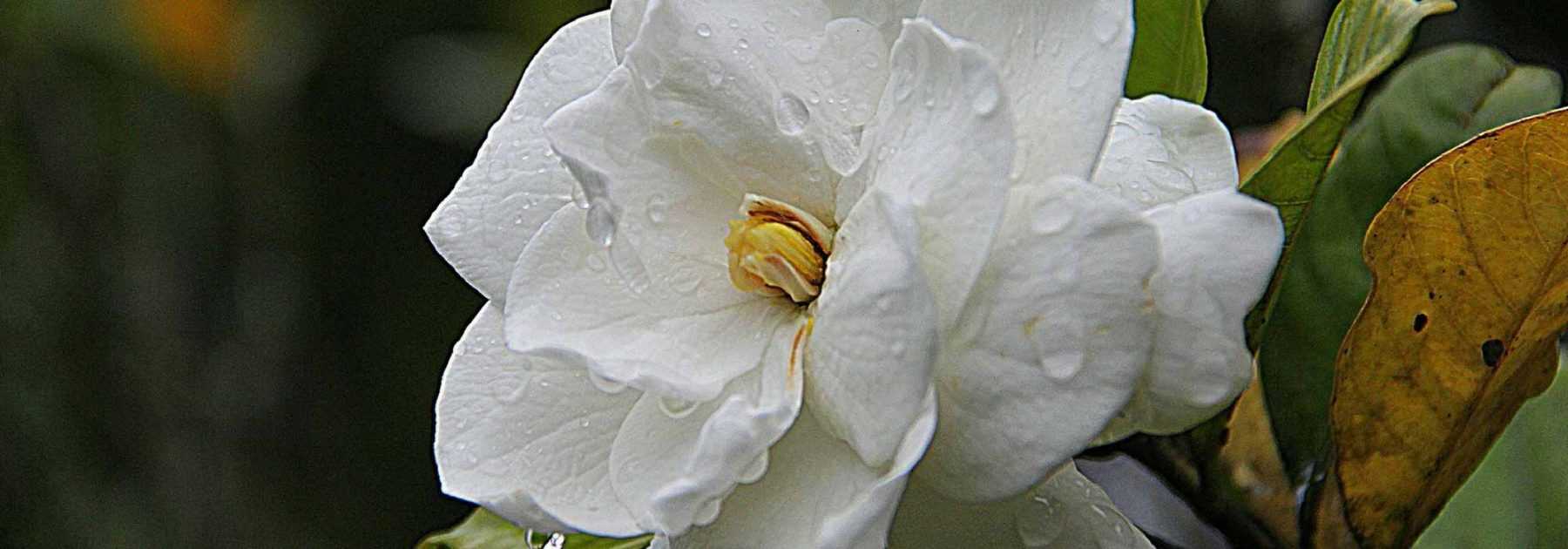
Gardenia: Planting, Care, Pruning, Watering
Contents
Gardenia in a Few Words
- The gardenia is one of the most divinely fragrant flowers in the plant world
- With its beautiful evergreen foliage, the Gardenia remains stunning even in winter when other plants are dormant
- Hardy down to -10°C for some varieties, it’s a tender shrub that can only be grown outdoors in mild regions
- Rather delicate to cultivate, it’s one of those shrubs that require perfect conditions to thrive
- It grows in fertile, acidic, moist yet well-drained soil and appreciates humid atmospheres
Our expert's word
If the Gardenia or “common gardenia” is an indoor shrub adored for its fragrant white flowers, it is also a magnificent plant, with some varieties capable of surviving outdoors in mild regions. However, it is difficult to imagine cultivating this shrub across all of France, as it prefers mild and humid climates.
Fortunately, in recent years, hardier and more cold-resistant gardenias have emerged and are beginning to find their way into our gardens, such as the Gardenia ‘Crown Jewel’. These gardenias offer the possibility of being grown both in the ground and in containers, delivering a striking and long-lasting effect.
If its addictive, intense, and voluptuous jasmine fragrance has inspired a novel, “The Red Gardenia,” and an iconic perfume by a very famous perfumer, the bloom of the gardenia remains invariably white to creamy-white, lasting from May to October.
Its glossy, dark green foliage provides a touch of greenery all year round, punctuated by numerous clusters of fragrant flowers from late spring onwards.
With rather delicate cultivation needs, it will reward you with gratitude in fertile soil, ideally ericaceous, cool but well-drained, where it will thrive sheltered from cold winds and stagnant moisture.
The gardenia is one of the most coveted shrubs among plant enthusiasts, a true treasure for the garden or terrace.
Discover the most beautiful outdoor gardenias and let yourself be enchanted by this sophisticated, fragrant, and floriferous shrub.
Description and botany
Botanical data
- Latin name Gardenia
- Family Rubiaceae
- Common name Gardenia
- Flowering May to September
- Height 0.60 to 2 m
- Exposure Sun, partial shade
- Soil type Neutral, acidic, well-drained
- Hardiness -10°C
The Gardenia is a shrub from the Rubiaceae family, native to Asia and South Africa. It is frequently found in the wild, on the edges of subtropical to tropical forests. The genus includes about 200 shrubby and evergreen species, but only Gardenia augusta (synonymous with G. florida, G. grandiflora and G. jasminoides, the most common species with an intoxicating jasmine fragrance) and its numerous American cultivars are commonly grown in our latitudes. Occasionally, Gardenia thunbergia can be found, which can grow up to 5 m tall and has spiral-shaped flowers.
It forms rather slowly into a small shrub with greyish bark and a bushy, supple and graceful habit, measuring between 60 cm to 2 m in height in our gardens but can reach up to 12 m in its natural habitat for some rare species. The Gardenia has a very long lifespan.
On rather flexible branches blooms, with rare elegance, the foliage, most often a glossy, varnished dark green. It is sometimes streaked with white (‘Veitchiana’). Oval, elliptical or lance-shaped, the leaves are 5 to 15 cm long, opposite or arranged in whorls of three or more around the stem. Entire, thick, leathery, evergreen, with very prominent veins and sometimes slightly wavy, they provide a dense and permanent green backdrop against which the flowers stand out.
Its sumptuous and very extended flowering throughout summer, with a floral, deliciously intoxicating fragrance, is its major asset. From May to September, pure white to ivory cup-shaped flowers appear, most often solitary or gathered in small cymes at the leaf axils, at the tips or along the branches. If conditions allow, some gardenias like ‘Veitchiana’ can continue to flower in winter, from January to March.
With a waxy texture, each flower opens into a silky corolla of 5 to 12 lobed petals, spreading 4 to 8 cm in diameter. They can be single (Gardenia ‘Kleim’s Hardy’), semi-double (Gardenia jasminoides ‘Summer Snow’) or fully double (Gardenia jasminoides ‘Crown Jewel’). The Gardenia thunbergia has tubular flowers with petals spirally overlapping.
They emit a floral jasmine fragrance, intense and voluptuous.
This evergreen shrub is planted in the ground, in partial shade, sheltered from scorching sun and drafts. Quite demanding, it only thrives in acidic soil, free from lime, fresh, fertile, light and well-drained, as well as in humid atmospheres. Of all climates, it prefers a mild, well-watered oceanic climate.
There are now quite hardy gardenias (down to -10°C to -12°C maximum in well-drained soil), capable of surviving in the ground during our not-too-harsh winters. In colder regions, the gardenia will be grown in large pots to be stored in winter, sheltered from severe frosts, like orangerie plants in an unheated conservatory or cold greenhouse.
Read also
Planting perennials and shrubsMain species and varieties
There are many species and varieties of gardenias, but only Gardenia jasminoides, the Cape Jasmine (synonyms Gardenia augusta, G. florida, G. grandiflora) with its intoxicating jasmine fragrance and its numerous American cultivars are commonly grown in our gardens. In recent years, hardier hybrid gardenias (-10°C to -15°C), such as ‘Kleim’s Hardy’ or ‘Crown Jewel’, have emerged, making it possible to grow gardenias outdoors in the ground in our mild-climate gardens.
The Most Popular

Gardenia jasminoides Kleims Hardy
- Blütezeit June to November
- Höhe bei Reife 80 cm
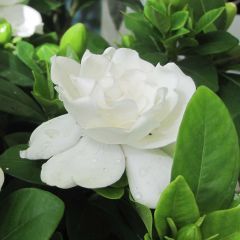
Gardenia jasminoides Crown Jewel - Cape Jasmine
- Blütezeit June to October
- Höhe bei Reife 1 m
Our Favourites
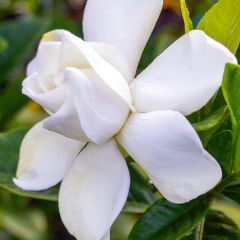
Gardenia jasminoides Summer Snow
- Blütezeit June to August
- Höhe bei Reife 1,10 m
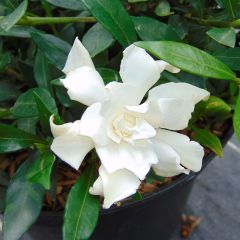
Gardenia jasminoides Perfumed Petticoats
- Blütezeit June to October
- Höhe bei Reife 75 cm
Planting
Where to Plant a Gardenia
Growing gardenias isn’t always straightforward, so it’s best to respect their rather delicate nature. It’s entirely possible to grow gardenias in the ground, but only in regions where frost is very rare. They clearly prefer climates with warm summers and mild, humid winters (from southern Brittany to Biarritz) as they cannot tolerate frost.
Like camellias, with which they share similar requirements, these somewhat tender shrubs can withstand brief, light frosts down to around -12°C (sometimes lower), but only south of the Loire, in very well-drained soil and in a sheltered spot away from draughts. The hardiness of gardenias varies depending on the duration of frost and soil moisture levels. Elsewhere, it’s best to grow them in pots that can be moved to a cold greenhouse in winter.
Plant them sheltered from cold, drying winds to improve their hardiness and help them cope with frost. Position gardenias in a partially shaded bed or where they’ll receive morning sun, protected from scorching sunlight, which can damage their foliage and flower buds. However, they need plenty of light to flower well, so avoid direct sun during the hottest part of the day.
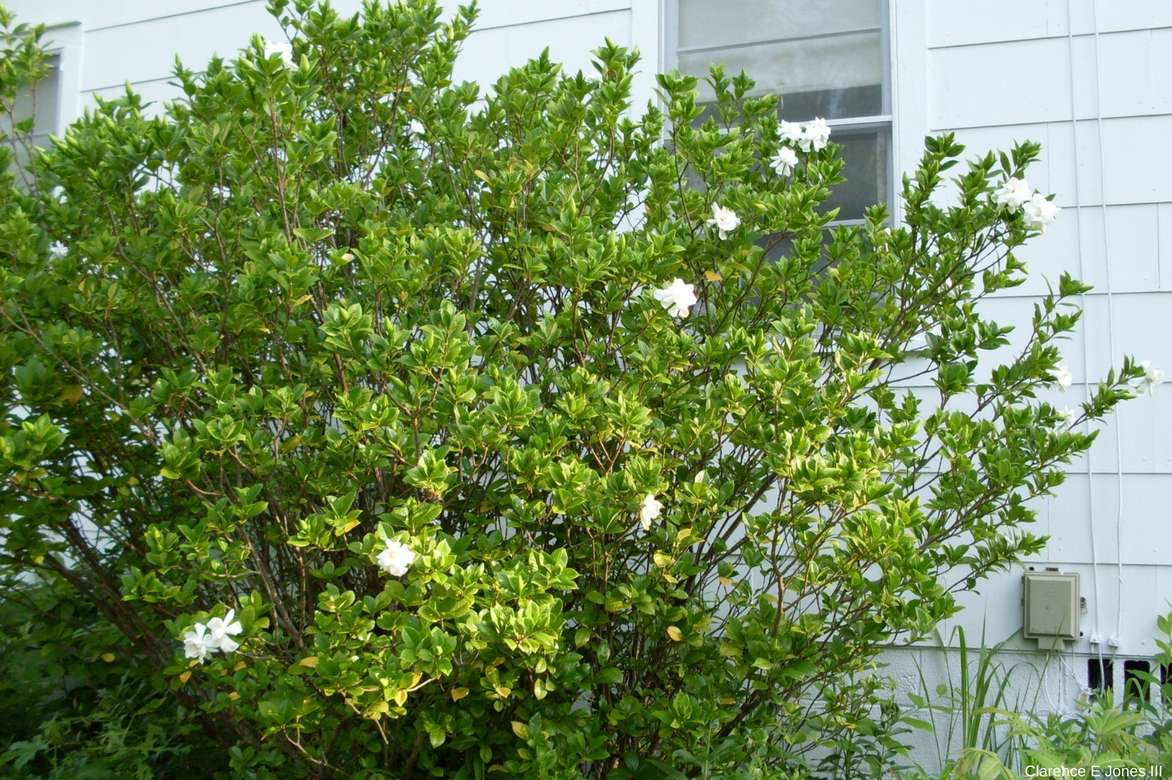

Plant your gardenia sheltered from cold winds, against a well-exposed wall, such as an east-facing one.
They thrive in fertile, acidic, well-drained soil that stays cool in summer. They dislike lime, so plant them alongside ericaceous (acid-loving) plants. They tolerate dry conditions very poorly, as well as excessive moisture, especially in winter, which will almost certainly cause root rot. While they handle heat well, water them regularly during heatwaves to maintain a humid environment.
In the garden, they’re perfect planted beneath large deciduous trees, which naturally provide the shade and drainage gardenias love. They’ll thrive even more when protected by a wall or hedge. They rarely exceed 1.5m in height at maturity, making them ideal for small gardens. Gardenias pair beautifully with other ericaceous plants like hydrangeas, pieris, kalmias, and rhododendrons.
This delightfully fragrant shrub deserves a prime spot on the patio, close to the house in a well-frequented area, where its sweet blooms can perfume the air.
When to Plant a Gardenia
Plant gardenias in the ground, ideally in spring, in May, once all risk of frost has passed. Autumn planting from September to November, after the peak heat, is also possible.
How to Plant Gardenias
In the ground
Gardenias need a well-draining, humus-rich substrate. Provide deep, light soil, acidified with ericaceous compost and some river sand, coarse gravel, or clay pebbles to improve drainage. Plant them in groups of 2 or 3 per m² for a striking display in borders. A single plant can create a lush effect, especially when mixed with other evergreen foliage. When combined with other shrubs, space them 50cm apart. Ensure good drainage (their roots dislike waterlogging) with a 20cm layer at the bottom of the planting hole.
- Soak the root ball in a bucket for a few minutes
- Loosen the soil to a depth of 25-30cm
- Dig a hole 3 to 5 times wider than the root ball
- Add a layer of pumice, peat, and gravel to the hole
- Plant the shrub level with the soil surface
- Enrich the soil with ericaceous compost, dried leaves, or river sand
- Backfill, firm gently, and water thoroughly after planting, then whenever the soil dries out during the growing season
Growing Gardenias in Pots
In pots, they dislike overly dry or stuffy conditions: maintain good ambient humidity and avoid placing them near radiators or in direct sunlight. Gardenias thrive in greenhouses or conservatories kept between 12–18°C but can be moved outdoors in summer, sheltered from draughts.
- Plant in a mix of ericaceous compost, indoor plant soil, and leaf mould
- Place clay pebbles at the pot’s base
- Stand the pot on a tray of water-filled pebbles
- Position in bright, indirect light
→ Learn more about planting and caring for potted gardenias in our guide
Maintenance, Pruning and Care
This shrub offers an abundant flowering each year, from spring to late summer… provided you give it a little attention and the right care. Whether in pots or in the ground, the gardenia requires very high ambient humidity to thrive.
In the ground
Water only with rainwater (it dislikes lime), without flooding the plant. Mist the foliage during hot spells but avoid wetting the flowers, as this discolours the blooms and causes spots on the leaves.
Every year, in spring and autumn, spread a thick layer of organic mulch (pine bark or needles, leaf litter) to keep its roots cool in summer and warm in winter.
If heavy frost is forecast, cover the aerial parts with horticultural fleece.
In winter, reduce watering to about once a week.
It requires regular feeding to support its flowering: in summer, apply acidic fertiliser for gardenias, specific for ericaceous shrubs, every fortnight. You can also incorporate compost or ericaceous fertiliser annually or biennially by lightly scratching it into the soil around the base.
Gardenia in pots
Water once or twice a week in summer with rainwater or spring water. Allow the soil to dry out between waterings. Place the pot in bright, indirect light, away from radiators, on a tray of water-soaked clay pebbles or gravel. In winter, watering every two weeks is sufficient. Apply a liquid acidic fertiliser for gardenias once a month.
In colder regions, move it outdoors during the warmer months and protect it from frost in winter by placing it in a greenhouse or conservatory.
Each year, top-dress in spring with a mix of compost and ericaceous soil. Repot every 2 to 3 years in late winter or early spring to ensure healthy growth: repot using a mix of compost and ericaceous soil or a special gardenia potting mix.
Pruning gardenias
Pruning the gardenia after flowering helps maintain a neat, compact shape.
- Lightly trim (by one-third) stems that disrupt symmetry
- Remove dead wood
- Deadhead spent flowers
to prevent exhausting the shrub and encourage better blooms the following year
Diseases and potential pests
A gardenia grown indoors will be more susceptible to diseases and attacks by parasitic insects. When planted outdoors, frost and excessive winter moisture are the main enemies of this tender shrub.
Aphids, scale insects and grey mould are the gardenia’s principal adversaries.
In case of an aphid infestation, remove the colonies by spraying the plant with water or washing the foliage with soapy water.
Use rapeseed oil sprays to smother scale insects.
Avoid hard water at all costs as it causes leaf yellowing and promotes chlorosis.
Sometimes flowers drop before even blooming, likely due to insufficient humidity: mist the leaves with soft water.
→ Also read our advice sheet: Gardenia Diseases and Pests.
Propagation
It is entirely possible to propagate a gardenia by cuttings in early spring.
- Take cuttings approximately 8-10 cm long
- Remove the lower leaves, keeping only the top pair
- Dip the cutting in rooting hormone
- Plant the stem cuttings in pots filled with a moist mixture of peat and river sand
- Place the cuttings in a warm (18–20°C), bright location without direct sunlight and with high humidity
- Keep the substrate slightly moist until rooting occurs, after about a month
- Plant the young plants in the garden the following spring
Pair
The gardenia is the star of shaded gardens, bringing light and sophistication with its profusion of delicate flowers. As a striking focal point or mixed with other shrubs in mild climates, it easily complements any setting.


A planting idea for acidic soil: Azalea ‘Ho Oden’, Pieris japonica ‘Debutante’, Hydrangea macrophylla ‘Etoile Violette’, Gardenia jasminoides ‘Crown Jewel’, Choisya ‘Apple Blossom’ beneath a Magnolia liliflora ‘Nigra’.
Exceptionally floriferous, it maintains a bushy habit with green foliage, making it a beautiful shrub for woodland edges. In heather beds, it pairs well with complementary shrubs that boast equally remarkable blooms, such as Rhododendrons, Pieris, Japanese Azaleas, Kalmia latifolia, Magnolias, Mexican Orange Blossoms, Deutzias, Camellias, and Hydrangeas, which will precede or follow its flowering period.
The densely flowered masses of gardenia will appear lighter alongside a magnificent Japanese maple with delicate, feathery foliage in soft green or deep red. It also pairs beautifully with plants featuring less dense foliage, such as Summer Heather ‘Spring Torch’, Ferns, and ornamental grasses.


Another shaded planting idea: Acer palmatum ‘Dissectum’, Carex oshimensis ‘Everillo’, Gardenia jasminoides ‘Crown Jewel’, Cyrtomium fortunei var. clivicola, Calluna vulgaris ‘Spring Torch’.
This evergreen shrub keeps a touch of green in the garden throughout autumn and winter. Planted at the back of a bed with other gardenias, it creates stunning floral displays all summer.
In pots, the gardenia makes a charming decorative feature year-round. It harmonises beautifully with the abundant blooms of Camellias and Japanese Azaleas.
Useful resources
- The most beautiful outdoor gardenias are here with us!
- Discover our ideas for pairing Gardenias
- For a fragrant garden, explore Virginie’s article: “The 10 best fragrant flowering plants”
- Care guide: Gardenia: how to protect it from cold and overwinter it?
- The perfumer’s plants
Frequently asked questions
-
For the past few weeks, my gardenia has been developing more and more yellow leaves - why is this happening?
It is common to see gardenia leaves turning yellow while the veins remain green. This tropical shrub requires plenty of warmth and ambient humidity to thrive, especially during its flowering period. When watering, avoid hard water at all costs, as it causes foliage to yellow and promotes chlorosis. Remove yellowed leaves and prune branches just above the buds.
-
My gardenia has brown leaves, is it serious?
If the leaves of your gardenia turn yellowish then brown and dry out, there could be several reasons for this. The first is that your gardenia may be getting too much sun exposure. If possible, move it to a spot sheltered from direct sunlight. Remove damaged leaves and water the plant thoroughly. The surrounding environment is likely too dry as well. In summer, regularly mist its foliage.
-
The flowers on my gardenia are falling and not opening, what should I do?
If the flowers drop before opening, it's likely due to insufficient humidity. Regularly mist the foliage with non-calcareous water, but avoid wetting the open flowers as this would discolour them and cause brown spots on the petals.
- Subscribe!
- Contents


































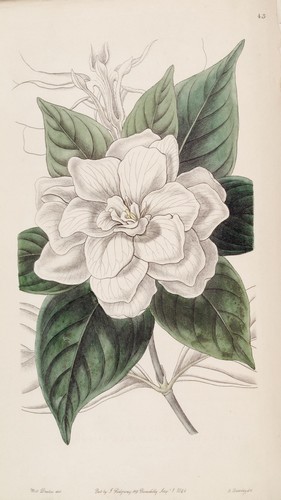

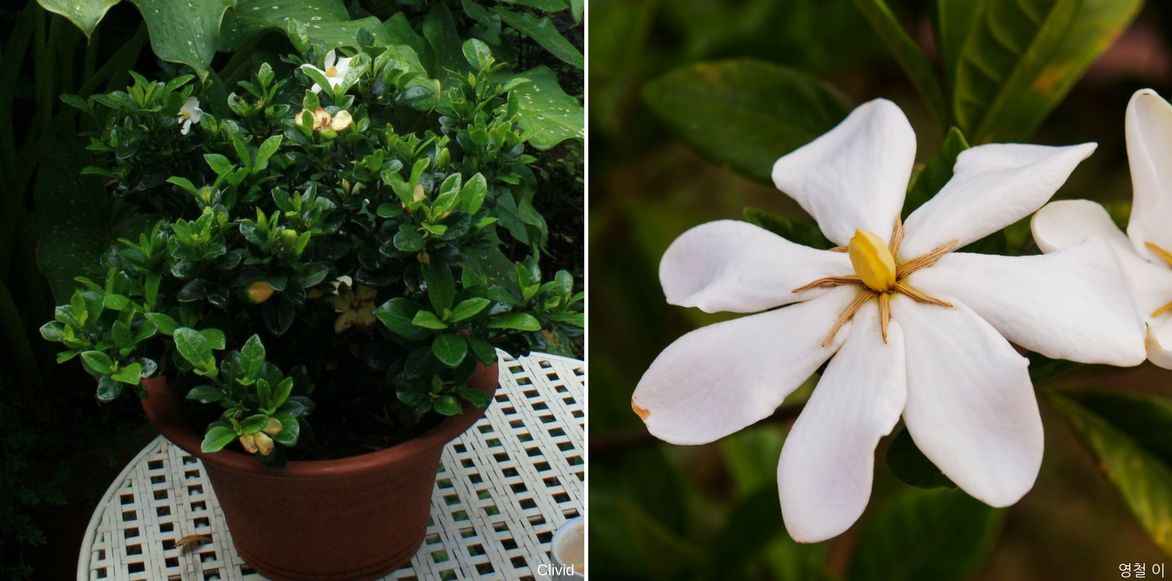

Comments